Rare cosmic events continue to fascinate astronomers and academics because they provide insights into the awe-inspiring power and complexity of celestial bodies. These events take place in the wide expanse of the cosmos. Neutron stars, which are the leftovers of enormous stars that have suffered a supernova explosion, are one of these, and they have fascinated astronomers for decades. A unique occurrence that occurred not too long ago involving a neutron star has just given rise to fresh hypotheses on its connection to magnetars, intense bursts of radio waves, and the mysterious role that asteroids play in the cosmos.
The Formation of a Magnetar During the Collapse of a Star and the Mystery of Radio Pulses
Magnetars are a subcategory of neutron stars that are formed when enormous stars run out of nuclear fuel and then collapse under their own gravity. Magnetars are generated from the debris left behind by these stars. An incredible celestial object has been produced as a result of this collision: it is a star remnant with a mass comparable to that of our sun, but it has been compressed into a width that is roughly equivalent to the width of the typical city on Earth. Magnetars are endowed with exceptional qualities as a result of the tremendous gravitational forces and magnetic fields that are produced as a byproduct of this process.
Astronomers have been perplexed for a long time by something called Fast Radio Bursts (FRBs) because of how elusive they are. These radio pulses, which can last anywhere from a fraction of a millisecond to a few seconds, have been spotted only very infrequently since they were first discovered in 2007. It wasn’t until 2020 that researchers uncovered a groundbreaking connection between FRBs and magnetars that the origin of FRBs was finally revealed.
The Extraordinary Evolution of a Neutron Star, Caused by an Error in the System
Astronomers noticed what appeared to be a “glitch” in the rotation speed of a neutron star in a recent study that caused shockwaves to be sent throughout the scientific world. The astounding occurrence took place not long after an asteroid was split apart by the enormous forces that were in action immediately after it had been dragged into the gravitational pull of the neutron star. This catastrophic collision resulted in the production of a powerful amount of radio waves, which are analogous to the unexplained FRBs.
The findings of this research point to the possibility that magnetars are the origin of FRBs. In accordance with the unchangeable principles of physics, the momentum that an asteroid carries through its now-defunct planetary system cannot be eradicated even when the asteroid is destroyed by being drawn into the gravitational grasp of a magnetar and annihilated.
FRB Generation from the Destruction of Asteroids as an Example of Astrophysical Fireworks
An astonishing phenomena takes place as the fragmented remnants of the annihilated asteroid fall onto the surface of the neutron star. Because of the force of the hit, intense bursts of energy are unleashed, which then radiate across a wide spectrum of light frequencies, effectively producing the mysterious FRBs.
Theoretically, the process starts when the asteroid gets dangerously close to the magnetar and enters the gravitational field of the magnetar, which is fatal. The tidal forces that are acting against the asteroid are greater than its structural integrity, therefore it is being torn apart in a stunning display caused by the cosmos. As the debris and dust from the deteriorating space rock fall toward the neutron star, they get superheated and release bright flashes of radiation over the electromagnetic spectrum.
The New Frontier in Astronomy: Deciphering the Relationship Between FRBs and Magnetars
Although the new research provides persuasive evidence of a connection between magnetars, asteroids, and FRBs, further investigation into the entire scope of this connection is still required. The scientific community is keen to gather further data and run additional simulations in order to test and improve upon this notion. It has the potential to be a significant step forward in our comprehension of these puzzling cosmological occurrences if it turns out to be right.
The mysteries of the universe are still being uncovered, but with each new finding, we come that much closer to knowing the wondrous celestial tapestry that wraps itself around us. The saga of neutron stars, magnetars, and the enigmatic FRBs promises to be one of the most fascinating chapters in the cosmic chronicle as astronomers and physicists peer further into the cosmos. As we piece together the puzzles of the cosmos, we realize that we are on the cusp of an exciting adventure into the uncharted territories of the universe.
![]()
